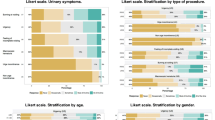Abstract
Purpose
The internal drainage provided by a ureteral stent helps with the relief and prevention of ureteral obstruction. By definition, correct stent placement is one with a complete loop in both the renal pelvis and bladder. This prevents stent migration proximally or distally despite urinary flow, patient movement, and ureteral peristalsis.
Methods
We performed a comparative prospective cross-sectional study assessing the impact of intravesical stent position on the quality of life in 46 patients with a ureteral stent. This is done using the Ureteral Stent Symptom Questionnaire (USSQ).
Results
52.5% of patients had an ipsilateral positioned intravesical stent, while the remaining had their stent positioned contralaterally. Intravesical stent position significantly influenced the quality of life. The USSQ score was worse for the contralateral group. Subscore analysis found that urinary symptoms and body pain index contribute significantly to the morbidity. Majority of patients in the ipsilateral group reported no discomfort as compared to the contralateral group.
Conclusions
To the best of our knowledge, this is the first study assessing the impact of intravesical stent position on the quality of life in the Asian population. Intravesical stent position has a significant influence on patient’s morbidity and quality of life in particular towards their urinary irritative symptoms and body pain. It is imperative to ensure correct distal placement of ureteric stent that does not cross the midline to the contralateral site. We believe that the USSQ should be used in daily clinical practice in assessing the symptoms related to indwelling ureteric stents.


Similar content being viewed by others
References
Giannarini G, Keeley FX Jr, Valent F et al (2011) Predictors of morbidity in patients with indwelling ureteric stents: results of a prospective study using the validated Ureteric Stent Symptom Questionnaire. BJU Int 107:648–654
Miyaoka R, Monga M (2009) Ureteral stent discomfort: etiology and management. Indian J Urol 25:455–460
Joshi HB, Stainthorpe A, MacDonagh RP et al (2003) Indwelling ureteral stents: evaluation of symptoms, quality of life and utility. J Urol 169:1065–1069
Joshi HB, Newns N, Stainthorpe A et al (2003) Ureteral stent symptom questionnaire: development and validation of a multidimensional quality of life measure. J Urol 169:1060–1064
Sameh WM, Eid AA (2012) Pressure transmission through ureteric stents: a novel in vivo human study. Urology 79:766–770
Lee SJ, Yoo C, Oh CY et al (2010) Stent position is more important than α-blockers or anticholinergics for stent-related lower urinary tract symptoms after ureteroscopic ureterolithotomy: a prospective randomised study. Korean J Urol 51:636–641
Abdelaal AM, Al-Adl AM, Abdelbaki SA et al (2016) Efficacy and safety of tamsulosin oral controlled absorption system, solifenacin, and combined therapy for the management of ureteric stent related symptoms. Arab J Urol. https://doi.org/10.1016/j.aju.2016.01.004
Anderson KE (2002) Bladder activation: afferent mechanisms. Urology 59:43–50
Thomas R (1993) Indwelling ureteral stents: impact of material and shape on patient comfort. J Endourol 7:137–140
Shao Y, Shen Z, Zhuo J et al (2009) The influence of ureteral stent on renal pelvic pressure in vivo. Urol Res 37:221. https://doi.org/10.1007/s00240-009-0199-z
Deliveliotis C, Chrisofos M, Gougousis E et al (2006) Is there a role for alpha1-blockers in treating double-J stent related symptoms? Urology 67:35–39
Abt D, Mordasini L, Warzinek E et al (2015) Is intravesical stent position a predictor of associated morbidity? Korean J Urol 56:370–378
Grunewald N, David C, Amos J (2015) Patient education and the impact on ureteroscopy experience. J Urol 193(4):75–80
Preminger GM, Tiselius HG, Assimos DG et al (2007) 2007 Guideline for the management of ureteral calculi. J Urol 178:2418–2434
Funding
None.
Author information
Authors and Affiliations
Corresponding author
Ethics declarations
Conflict of interest
The authors declare that they have no conflict of interest.
Ethical approval
All procedures performed in this study were in accordance with the ethical standards of the institutional research committee (The National University of Malaysia Research Ethics committee, reference number UKM PPI/111/8/JEP-2016-453) and with the 1964 Helsinki declaration and its later amendments or comparable ethical standards.
Informed consent
Informed consent was obtained from all individual participants included in the study.
Additional information
Publisher's Note
Springer Nature remains neutral with regard to jurisdictional claims in published maps and institutional affiliations.
Rights and permissions
About this article
Cite this article
Inn, F.X., Ahmed, N., Hou, L.G. et al. Intravesical stent position as a predictor of quality of life in patients with indwelling ureteral stent. Int Urol Nephrol 51, 1949–1953 (2019). https://doi.org/10.1007/s11255-019-02262-7
Received:
Accepted:
Published:
Issue Date:
DOI: https://doi.org/10.1007/s11255-019-02262-7




